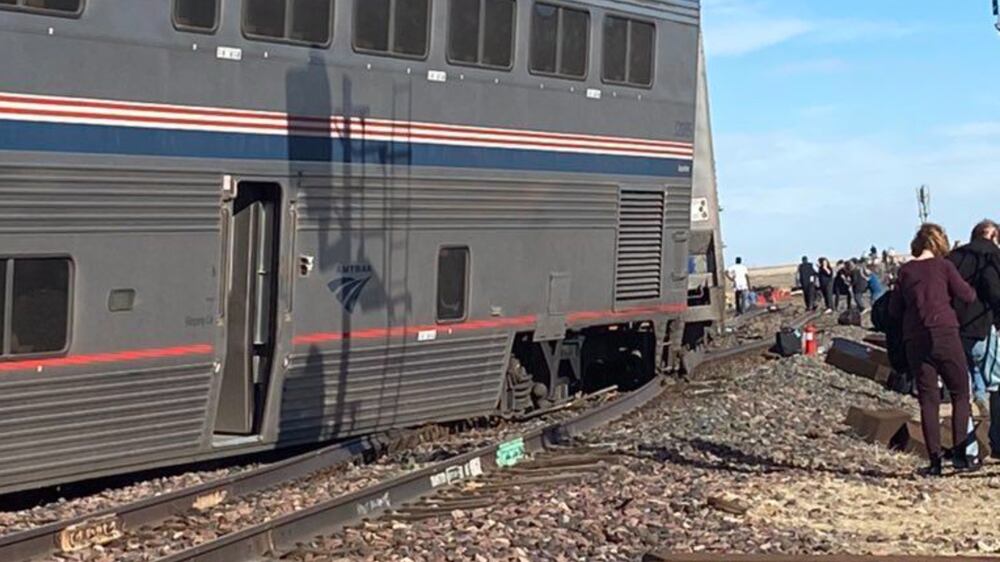Federal officials sent a team of investigators from the National Transportation Safety Board to the site of an Amtrak derailment in north-central Montana, which killed three people and left seven in hospital on Sunday, officials said.
The westbound Empire Builder was travelling to Seattle from Chicago when it left the tracks about 4pm Saturday near Joplin, a town of about 200.
The train was carrying 141 passengers and 16 crew members, and had two locomotives and 10 cars, eight of which derailed, Amtrak spokesman Jason Abrams said.
A 14-member investigative team would look into the cause of the derailment on a BNSF Railway main track, which involved no other trains or equipment, NTSB spokesman Eric Weiss said.
Police said the officials from the NTSB, Amtrak and BNSF arrived at the site, which cuts through recently harvested wheat fields.
Large cranes were taken to the tracks, which run almost parallel to US Highway 2, along with lorry loaded with gravel and new railroad ties.
The accident scene is about 240 kilometres north-east of Helena and about 48km from the Canadian border.
Most of those on the train were treated for their injuries and released, but five remained at the Benefis Health System hospital in Great Falls, Montana, said Sarah Robbin, Liberty County emergency services co-ordinator. Two were in the intensive-care unit.
Another two people were at a hospital in Kalispell, Montana, spokeswoman Melody Sharpton said.
Liberty County Sheriff Nick Erickson said the names of the dead would not be released until relatives were notified.
Ms Robbin said nearby residents rushed to offer help when the derailment occurred.
“We are so fortunate to live where we do, where neighbours help neighbours,” she said.
Amtrak said it sent emergency personnel and other officials to the site to help passengers, employees and local officials. It said company officials were “deeply saddened” to learn of the deaths.
Because of the derailment, Sunday’s westbound Empire Builder from Chicago will terminate in Minneapolis, and the eastbound train will originate in Minneapolis.
Passenger Megan Vandervest told The New York Times she was awakened by the derailment.
“My first thought was that we were derailing because, to be honest, I have anxiety and I had heard stories about trains derailing,” Ms Vandervest, of Minneapolis, said at the Liberty County Senior Centre, where some passengers were taken.
“My second thought was that’s crazy. We wouldn’t be derailing. Like, that doesn’t happen.”
She said the car behind hers was tilted, the one behind that was tipped over, and the three cars behind that “had completely fallen off the tracks and were detached from the train".
Ms Vandervest said it felt like “extreme turbulence on a plane.”
Residents of communities near the crash site quickly came together to help.
Chester Councilwoman Rachel Ghekiere said she and others helped about 50 to 60 passengers who were brought to a school.
“I went to the school and assisted with water, food, wiping dirt off faces,” Ms Ghekiere said.
“They appeared to be tired, shaken but happy that they were where they were. Some looked more disheveled than others, depending where they were on the train.”
A grocery shop in Chester, about 8km from the derailment, and a nearby religious community provided food, she said.
The passengers were taken by buses to hotels in nearby Shelby, said Ms Ghekiere, whose husband works for the local emergency services agency and was alerted to the crash.
Photos on social media showed rail cars on their sides and passengers standing alongside the tracks, some carrying luggage.
The images showed sunny skies, and it appeared the accident occurred along a straight section of tracks.
Allan Zarembski, director of the University of Delaware’s Railway Engineering and Safety Programme, said he did not want to speculate but suspected the derailment came from a problem with the track or equipment, or both.
Railways have “virtually eliminated” major derailments by human error after the implementation of positive train control nationwide, Mr Zarembski said.
“I would be surprised if this was a human-factor derailment,” he said.
NTSB findings could take months, Mr Zarembski said.
Bob Chipkevich, who oversaw railroad crash investigations for several years at the NTSB, said the agency would not rule out human error or any other possible causes for now.
“There are still human performance issues examined by NTSB to be sure that people doing the work are qualified and rested and doing it properly,” Mr Chipkevich said.
He said track conditions had historically been a significant cause of train accidents.
Mr Chipkevich said most of the track that Amtrak used was owned by freight railroads and it depended on those companies for safety maintenance.







